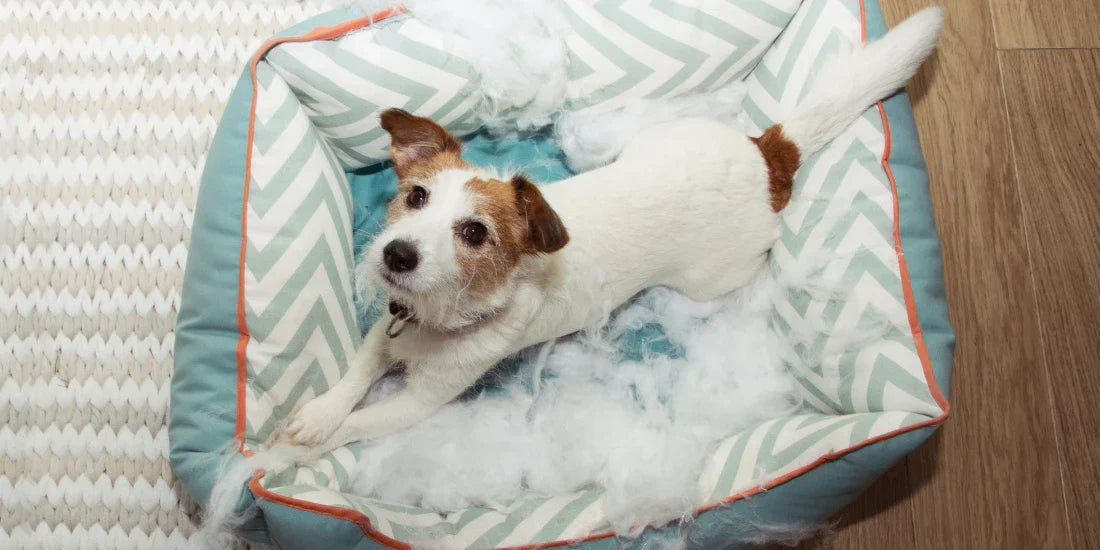
Recognising and Managing Separation-Related Anxiety in Dogs
|
|
Time to read 4 min
|
|
Time to read 4 min
Does your dog freak out every time you leave? Do you come home to chewed furniture, excessive barking complaints from the neighbours, or evidence of stress like drooling or pacing? These could all be signs of separation-related anxiety!
Dogs are social creatures, and for some, the absence of their beloved human can be truly difficult to bear. Understanding and recognising the symptoms of separation anxiety is the first step towards helping your dog feel secure, even when you’re not at home.
Read on to learn about recognising the signs of separation anxiety in dogs, understand what causes it, and find practical tips to manage it effectively.
Separation-related anxiety is a behavioural issue where dogs experience extreme distress when left alone or separated from their owner. This is not the same as your dog feeling sad when you leave—this condition is more intense, and the symptoms may disrupt their wellbeing and your household routine.
If your dog exhibits behaviours like chewing, digging, barking excessively, or even trying to escape the home in your absence, it could be dealing with separation anxiety. The good news? With the right intervention, this condition can often be managed effectively.
Separation anxiety can stem from many factors, including:
Change in routine: A sudden alteration in your schedule, like going back to the office after working from home, can confuse your dog.
Adoption history: Dogs rescued from shelters or rehoming situations may have a deeper fear of abandonment.
Prior trauma: Past stressful experiences, like being left alone for long periods or improper training, can cause anxiety.
Understanding your dog’s specific triggers makes it easier to address the problem.
It’s important to determine if the behaviours your dog displays are rooted in anxiety or if they’re just naughty habits! The following are some common signs of separation-related anxiety in canines.
Coming home to shredded cushions or scratched doors? This destructive behaviour is common in anxious dogs trying to “escape” their distress or seek comfort. Some dogs might target objects that carry their owner’s scent, like clothes.
Does your dog bark non-stop as soon as you leave the house? Prolonged barking, whining, or howling—especially when directed towards no one—can indicate they’re struggling with your absence.
If your house-trained dog starts having accidents inside while you’re away, it might be because they’re too anxious to hold it in. Some dogs may even mark their territory out of stress.
Anxious dogs might pace up and down repeatedly or display restlessness whenever they sense their owner is about to leave. This can continue long after you’ve left.
Stress can manifest physically, too. If your dog refuses food or chews excessively, this could be their way of showing discomfort when left alone.
Separation anxiety can be emotional for both you and your dog. But don’t worry—there are plenty of strategies and tools to help your pup feel calmer in your absence.
Designate a cosy space like a crate or a room filled with your dog’s favourite toys, bedding, and maybe even an item that carries your scent. This “safe zone” gives them a haven while you're out.
Dogs pick up cues like putting on shoes or grabbing keys that signal you’re leaving. Try making these actions less dramatic by doing them without actually leaving or pairing them with positive experiences like treats.
When you do come home, avoid making a fuss. Instead, calmly greet your dog after a few minutes to lessen the association between your return and excitement.
Ease your dog into spending time alone. Start by leaving the room for short periods, gradually extending the duration over days or weeks. This slow introduction helps build their tolerance for being solo.
A tired dog is a happy dog! Make sure your pup gets plenty of physical and mental stimulation before you leave. Activities like a long walk, playing fetch, or training exercises can burn off their excess energy and reduce stress.
Explore calming aids like anxiety wraps (e.g., Thundershirts), pheromone diffusers, or white noise machines to help keep your dog at ease. Some dogs even respond well to soothing music specifically designed for pets!
For more immediate relief, calming supplements can be a game-changer. Look out for natural ingredients like L-theanine, chamomile, or melatonin —all known for reducing stress in dogs.
If your dog’s anxiety persists or worsens, don’t hesitate to reach out to a professional dog trainer or behaviourist. They can design a personalised plan tailored to your dog’s needs.
Consistency is crucial when managing separation anxiety. Dogs thrive on predictable routines, so try to keep feeding, walking, and playtimes consistent. Also, give your dog plenty of love and attention when you’re home to reassure them they’re safe and cherished.
You’re not the only dog owner tackling separation anxiety, and sharing experiences can be incredibly helpful. Join a local dog-loving community or connect on social media to gather support and swap tips!
And remember, you’re not alone in this—patience and persistence go a long way. With time, you can help your dog feel confident, even when they’ve got the house to themselves.
If you're struggling to manage your dog’s separation anxiety, reach out for help! Whether it’s consulting a dog behaviourist or exploring training classes, there’s plenty of help available to get your dog back to their happy self.
Your dog’s wellbeing is worth it, and so is your peace of mind!